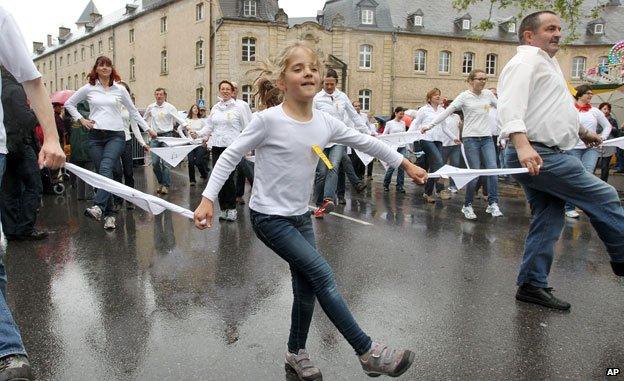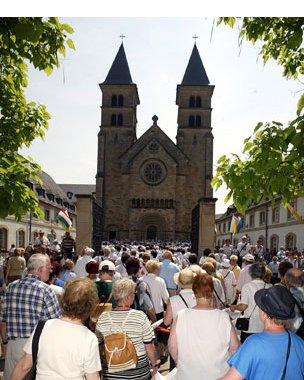Luxembourg's hopping heritage
- Published

Luxembourg is one of Europe's smallest countries, bordered by two of its largest - Germany and France. This may be one reason why its national character is, for many people, hard to pin down. Could a peculiar religious dance hold a clue?
Despite centuries of foreign domination, wars and disease, Luxembourgers have never stopped hopping - a bouncy dance to the tune of a polka, in honour of their British patron saint.
For a religious ceremony, it's a surprisingly light-hearted occasion. It has also been a gesture of defiance to all those, often foreigners, who have tried to put a stop to the tradition, and in some cases threatened Luxembourg's survival as a country.
Now it's Europe's largest traditional dancing procession, held on Whit Tuesday, when some 10,000 hoppers converge on the city of Echternach, along with up to 40,000 spectators.
The hero of the occasion is St Willibrord, the so-called Apostle of Benelux, an Anglo-Saxon missionary from Ripon in North Yorkshire, who is credited with driving paganism out of Belgium, the Netherlands and Germany in the 8th Century.
Pilgrims have been flocking to his tomb in Echternach abbey since the Middle Ages. Exactly when the hopping began is unclear, but the Catholic Church viewed it as a pagan ritual, and was the first to impose a ban.
"They were suspicious because the event was created by the people for the people," says Theo Peporte, spokesman for the Catholic Church in Luxembourg.
"They weren't sure if it was based on folklore or part of proper religious rites."
The Luxembourgers paid no notice, and continued happily hopping until, centuries later, the Church came round to their point of view.
"Eventually the Church understood that the hopping was to be taken seriously as a form of physical prayer and meditation. And today, the archbishop of Luxembourg actually leads the procession," says Peporte.
The dance starts early in the morning in the courtyard of the abbey founded by Willibrord in 698 AD, and slowly moves around the town centre.
From tiny toddlers to octogenarians with walking sticks, the participants are split into 45 groups containing rows of five dancers.
Hopping along with the celebration of St Willibrord
Most are dressed in simple white tops and black skirts or trousers. Fancy dress and national dress are not allowed.
"You are watching a procession, not a folklore performance, so please show restraint. No clapping, please!" warns a small notice in a brochure distributed to spectators.
A marching band starts up a catchy polka tune, which is played over and over again until the procession ends a few hours later, inside the abbey's crypt.
Once a multi-step affair involving backwards jumps, the modern version of the dance is quite simple - a little jump to the right, a little jump to the left, and hop you go.
"You can learn that in 10 seconds," says Peporte.
"What's harder is to remain synchronised with the others. That's the tricky part."
The secret, he reveals, is a handkerchief. The dancers in each row hold on to a folded cloth, "which helps to connect people and ensures harmonious hopping".
To the novice observer, the moving crowds seem to morph into one large bouncy mass.
But the expert eye will quickly spot subtle regional differences, says Pierre Kauthen, the president of the Willibrord Society, which organises the procession.
"While we Luxembourgers do a simple hop, German pilgrims swing their legs more energetically and throw them a little higher," he explains.
"Belgians are more relaxed about it and take two little steps."
Others followed the church in trying to ban the procession. One attempt was made by Holy Roman Emperor Joseph II, and another, a couple of centuries later, by the Nazis.
But in 1941, a group secretly hopped inside the abbey, despite the German prohibition. The act of defiance led to imprisonments and "that was that for the procession", says Kauthen, "but only until the war was over".
The sound of retreating Nazi marching boots was still echoing through the bombed streets of Echternach, when its residents crowded into the streets in 1945.

Outside the abbey, on hopping day
Accompanied by harmonicas and flutes, they skipped through the rubble of the basilica, which had been blown up by the Germans shortly before Luxembourg's liberation.
A Franciscan monk at this year's procession recalled joining the first post-war procession as a schoolboy.
"It was very gloomy and depressing on the one hand, because the whole town lay in ruins after the Battle of the Bulge," he said.
"The abbey was destroyed and looked horrendous. But there was a real spirit of determination in the air, and that was definitely expressed in our hopping."
In many ways, the procession is testimony to Luxembourg's national motto: "We want to remain what we are" (or "Mir welle bleiwe wat mir sin").
So much so, in fact, that the Willibrord Society fought long and hard to get the tradition protected by Unesco.
In 2010, the hopping parade was finally inscribed on Unesco's list of the Intangible Cultural Heritage of Humanity.
The convention safeguards creative practices handed down from generation to generation, which communities and groups recognise as part of their cultural heritage.
"It also means that the government has committed itself to enshrine the procession in its legislation," says Mr Kauthen, one of the main figures behind the Unesco campaign.
"As a result, Whit Tuesdays will always have to be a bank holiday for schoolchildren, which is very important. Because if the teenagers and children don't come, neither will their parents, and that could spell the the end for the hopping."
For the mayor of Luxembourg City, Xavier Bettel, the event represents an essential cornerstone of local tradition.
With foreigners making up two-thirds of those living in the "melting-pot capital", he sees it as one of the only remaining features of Luxembourgish culture.
"Let's be honest, this isn't just about faith and many of those attending aren't necessarily Catholic," he says.
"We are a tiny country and there aren't a lot of things left that bind us as a people. We have our languages but otherwise not much else. So it's important that this survives."